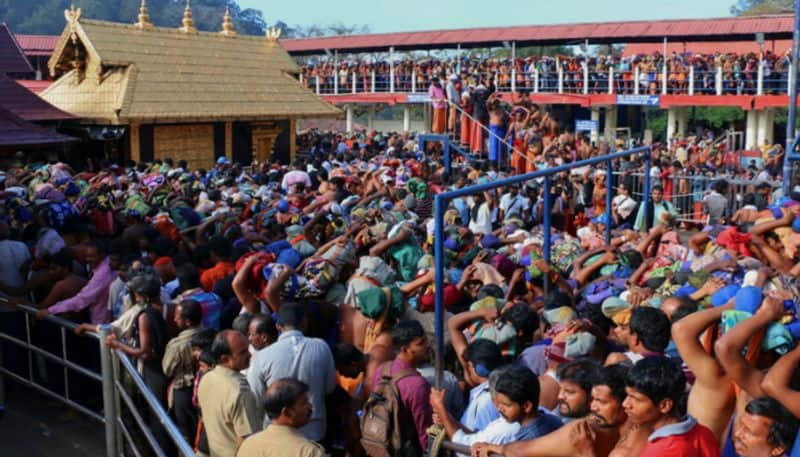Scratch the surface beyond the optics of the protests and you will see a visible political hand that has stirred the emotional pot. The face-off has brought together the BJP and the Congress on the same platform over Sabarimala.
Black is the colour associated with the Sabarimala pilgrimage. But as the temple prepared to open after its customary break on Wednesday, it turned into khaki with a huge Kerala police contingent deployed to ensure protesters, especially women, do not stop women devotees in the age band of 10 to 50 years, from proceeding towards the shrine of Lord Ayyappa. Traditionally women of menstruating age have been for years, forbidden from visiting Sabarimala. But in a landmark judgement on 28 September, the apex court opened the doors of the Sabarimala temple to everyone, irrespective of gender and age. The then Chief Justice Dipak Misra had said : ``The right guaranteed under Article 25 has nothing to do with gender and physiological factors''.
The pictures from Lord Ayyappa territory convey deep irony. God in God's own country is being protected from two different sets of people ranged against each other - the cops trying to ensure all women can visit his temple and the others to protect the Lord from such devotees.
Nilakkal, 20 km before Sabarimala, emerged as the theatre of protest. It was here that every vehicle on Tuesday and even Wednesday was being checked for women devotees and their age assessed, even as the police force looked the other way. If any young woman was found on the vehicle - be it a public transport bus or a private vehicle - she was forcibly taken out amidst verbal and physical abuse by the vigilante crowd that had taken it upon itself to defy the Supreme court verdict. Realising that failure to implement the court verdict would invite censure, the Pinarayi Vijayan government pressed more forces on the ground with orders to proactively ensure no protester has his or her way. Did it work? No, not really.
Among those targeted and even physically assaulted by the protesters have been journalists as well, out there to cover what most see as a historic event. The protesters made no distinction between a female devotee and a woman journalist, with misogyny on full display. The visuals of vandalism insulted the image of a typical Ayyappa bhakt, who is obsessed with his connect with the Lord. On the ground in Kerala, it has pitted the state versus a section of its people, law versus faith, release of the fetters in a metaphorical sense versus years of cultural and social conditioning of the mind.
But what brought about such anger? Those spearheading the protests believe the ones landing up at Sabarimala have zero devotion and are more obsessed with a photo-op. For the devout, the young women praying before the sanctum sanctorum at Sabarimala is not akin to breaking the glass ceiling. They believe the cry of ``Sabarimala, Here We Come'' betrays a Make My Trip kind of touristy approach to what they see as a very pious holy trip. For the Ayyappa bhakts, any woman devotee making the trek without the mandatory penance amounts to defiling the spirit of devotion. It is this angst that has turned this part of Kerala into an exhibition of mobocracy trying to trump the court verdict.
At a personal level, I do not consider menstruating women as impure or unclean. It is each individual's personal wish whether she wants to go to a place of worship during those four days. To debar all women on that one premise, prima facie, therefore is discriminatory.
But then is it just a case involving temple entry or is it more of a cultural issue? The argument in favour of status quo has been that Ayyappa at Sabarimala is a tribal God and the court verdict did not take into account the sensitivities of the devout of his patch. The devout fear next on the agenda would be to remove the rigorous dos and donts that are observed while praying at Sabarimala.
But should the protests have taken this form? No. To adopt violent means over a matter of faith is repugnant. But at the same time, what has reduced Sabarimala into a flashpoint is the activist approach that threatens to reduce Sabarimala to just another pilgrim centre. What most have failed to understand is that Sabarimala is not just another place of worship, it is an experience. An attempt to purge the body and by extension, the family of negativity with the positive vibes that are created through prayers and penance during those 41 days. Of course, conversely it can be argued that most male devotees have now adopted shortcuts and go to Sabarimala after a penance of just a week or 10 days and are not best placed to argue women can't do the same.
Those who have been regulars to Sabarimala for over three decades tell me the pristine nature of the place is already destroyed in the name of pilgrim amenities. What made Sabarimala different from say a Tirumala-Tirupati or a Guruvayoor, was how the pilgrimage tested the body and the mind. You had to walk for hours at end through difficult forest terrain. With motorable roads now, the walking distance is at best 32 km now.
The devout feel that at risk in the name of gender equality is to reduce Sabarimala to a stop on the temple tourism calendar. While I admit that the fragile ecology around Sabarimala ought to be protected, to blame women for it in advance smacks of sexism.
But scratch the surface beyond the optics of the protests and you will see a visible political hand that has stirred the emotional pot. The face-off has brought together the BJP and the Congress on the same platform over Sabarimala. Both parties see a sizeable constituency of Malayalees who prefer status quo over Sabarimala and are keen to tap into that sentiment ahead of the 2019 elections. The Congress has in fact, spoken in two voices - Delhi and Thiruvananthapuram. The local unit has stayed true to its decision to maintain status quo because it realises that at a time when the LDF is opposed to filing a review petition, the angry traditional Hindu vote could go into the BJP kitty unless the Congress steps in.
Could the LDF government have handled this better? Of course. Either it deliberately let things get out of hand or seriously miscalculated the emotions of the protesters. Chief minister Vijayan's decision to go on the foreign trip to mobilise funds for the state post the floods also was untimely as the situation warranted quick decision-making at the top. Internally, the CPI(M) would be conscious of how the Hindu vote could behave six months from now. The ruling party runs the risk of being seen as blind to the sentiments of the devout. How the other LDF constituents react politically to the developments on Wednesday, could determine Vijayan's next step over Sabarimala.
The government of the day is dutybound to obey the Supreme court verdict but what the protests demonstrate is that the devotees see Lord Ayyappa as a higher authority than the five-judge bench. It is their way of saying we do not believe the Constitution of India should get into a matter of religion and deep faith. That Ayyappa is beyond the any kind of jurisdiction.
`We the People of India' has been altered to `We the Devotees of Ayyappa'.
Last Updated Aug 19, 2019, 4:40 PM IST











![Salman Khan sets stage on fire for Anant Ambani, Radhika Merchant pre-wedding festivities [WATCH] ATG](https://static-ai.asianetnews.com/images/01hr1hh8y86gvb4kbqgnyhc0w0/whatsapp-image-2024-03-03-at-12-24-37-pm_100x60xt.jpg)
![Pregnant Deepika Padukone dances with Ranveer Singh at Anant Ambani, Radhika Merchant pre-wedding bash [WATCH] ATG](https://static-ai.asianetnews.com/images/01hr1ffyd3nzqzgm6ba0k87vr8/whatsapp-image-2024-03-03-at-11-45-35-am_100x60xt.jpg)



